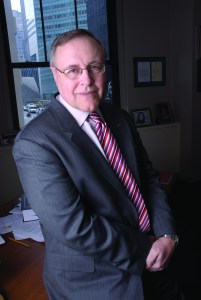Power Emeritus: Steven Spinola
By Lauren Elkies Schram April 29, 2015 9:45 am
reprints

What a long strange trip it’s been for Steven Spinola, who has been truckin’ along as head of the influential Real Estate Board of New York for nearly 30 years.
Mr. Spinola began his tenure in 1986 during the Koch administration and since then has been the public face of the real estate trade association, growing it to a record 16,000 members last year from around 4,000.
On his watch, REBNY brought more transparency to the industry, having launched the REBNY Listing Service through which brokers can share their listings, which was a major feat.
“When I first came here, if I raised the issue of doing that, one or two people would get up out of their seats and walk out of the room,” Mr. Spinola recently told Commercial Observer. “Back then you didn’t share listings in Manhattan. It was something you held onto. Today, that industry has come into the 21st century and shares their listings. We have a terrific computer program that does this.”
Mr. Spinola is proud that REBNY has been a platform that allows for the industry to be more unified, whether through award ceremonies or classes or charitable efforts or lobbying.
“I think for nearly 30 years, the industry has been brought together to almost function as one voice,” he has said. “And I think that has done more for the industry than anything else.”
As a lobbyist and interest group, REBNY has been quite active. Last year alone, REBNY assembled 39 apartments from members to house families left homeless by a building explosion on East 116th Street. Its members rallied against the pied-à-terre tax, a proposal to impose annually a tax on non-resident owners of condo and co-op apartments as well as Class 1 properties worth $5 million or more. Finally, REBNY played a role in the development of Mayor Bill de Blasio’s affordable housing plan, which calls for building and preserving 200,000 units of affordable housing throughout the city.
But not all has been smooth during Mr. Spinola’s reign.
The 66-year-old, whose wife in February stepped down as head of the residential and commercial brokerage divisions at REBNY after 20 years, led the organization during the mountain of controversy over Jobs for New York, a political action committee largely backed by REBNY, which spent millions supporting candidates in the 2013 City Council elections—millions sometimes the candidates didn’t even want. The candidates were concerned about being connected to a lobby many thought already exerted undue influence in elections and did not have lower- and middle-class voters’ interests in mind when it came to housing.
If nothing else, that was further evidence of the power of real estate in this town.
Thirty-eight percent of all of the locally generated revenue comes from income-producing properties through real estate taxes and other taxes, Mr. Spinola told CO.
“Well, that’s over $15 billion,” he previously said. “It pays for every cop, fireman, sanitation worker, teacher and correction officer [in the city] and leaves about $2.5 billion left over for libraries and other stuff. And then if you throw in the real estate taxes from the co-ops, the condos, it’s 54 percent. That’s why lately I say this is not a Wall Street town. This is a real estate town.”
As Mr. Spinola’s REBNY tenure winds down, John Banks prepares to step into his big shoes. In March, Mr. Banks, who spent 13 years as the vice president of government and community affairs at Consolidated Edison, officially became the president-elect of REBNY and he will assume the presidency by the end of 2015. Mr. Spinola will become president emeritus for which he has assured he will remain available for questions and advice.


